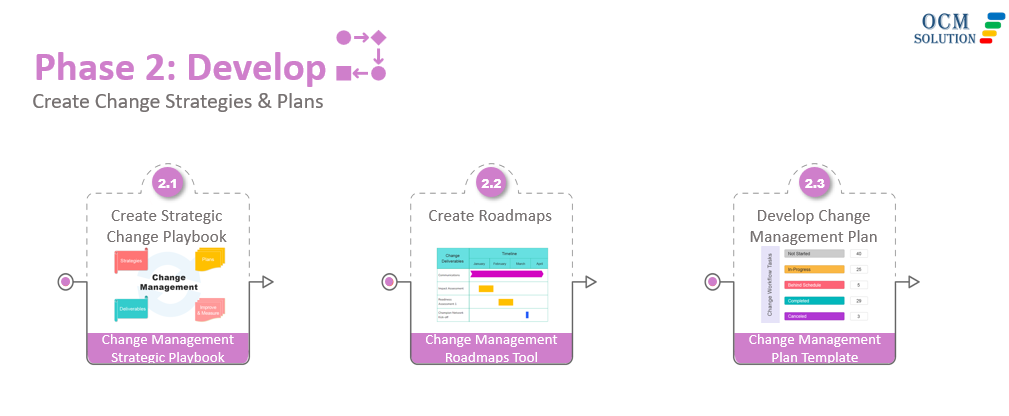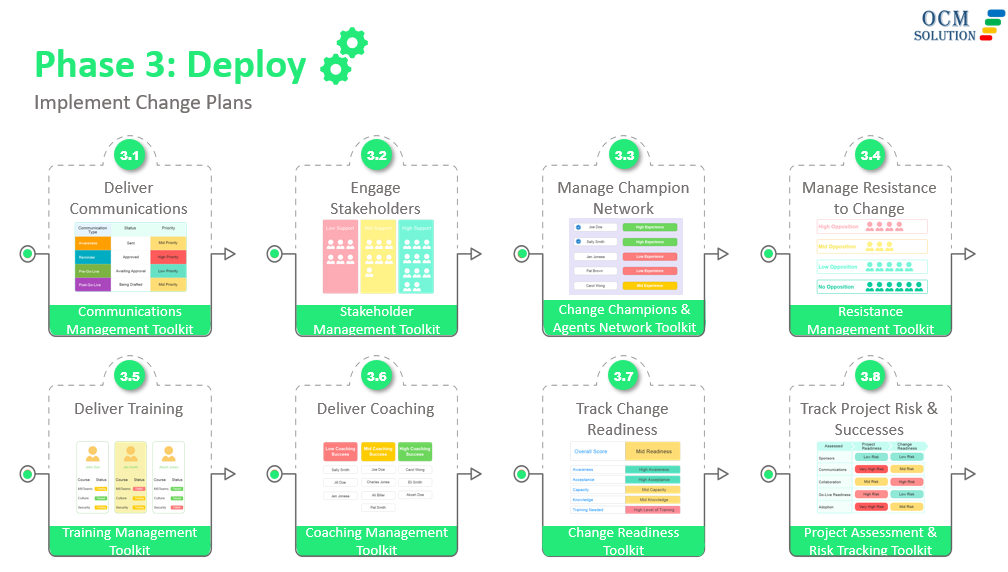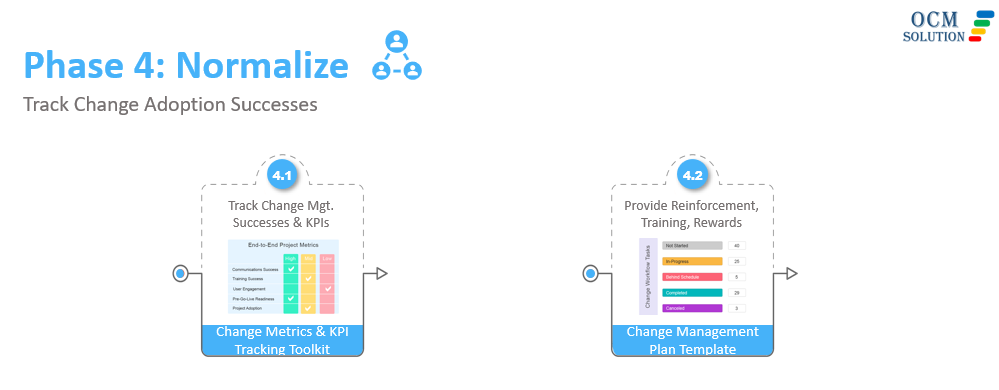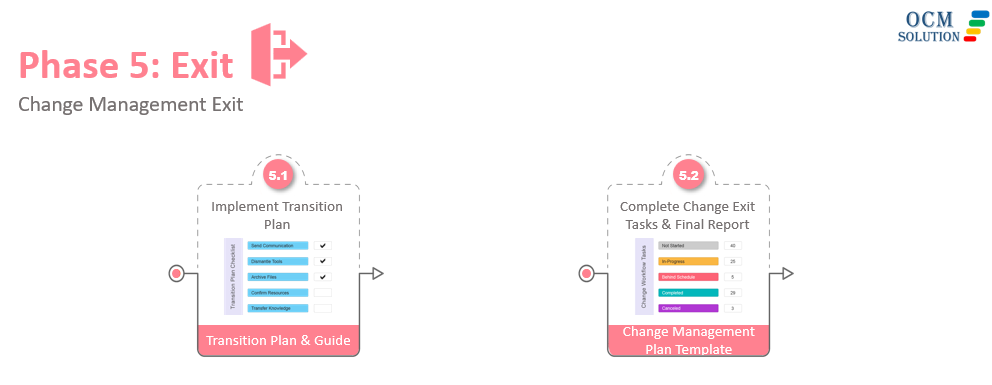A Proven, Repeatable Change Management Model for Change Managers and Project Teams
Ever found yourself in the whirlwind of the changes a project brings, for which you are expected to provide OCM support? Want to know how to navigate the storm with a smile? That’s where a great change management framework comes in handy. But not just any OCM framework will do. It needs to be easy, flexible, and repeatable.
 Change enablement and management of change doesn’t happen without a plan. But many change practitioners and organizations have a hard time finding change management models that work for them. They’re either too hard and complex, or too vague with no clear step-by-step process to follow.
Change enablement and management of change doesn’t happen without a plan. But many change practitioners and organizations have a hard time finding change management models that work for them. They’re either too hard and complex, or too vague with no clear step-by-step process to follow.
Managing change can be daunting, but with the right organizational change framework, enabling successful change can be smooth sailing.
Below, we’ll tell you which change model has been a proven winner. From large enterprises to small businesses, the OCM Solution Change Management Framework has been a favorite of many.
Looking for a Quick Summary? Read on. Want to dive deeper? Following the summary, you can enjoy a detailed discussion of our change management model and how you can use it to manage change management.
Quick Summary
Overview of the OCM Solution (OCMS) Organizational Change Management Framework
How does the OCMS Change Model work?
What makes an effective change management model? It’s all about simplicity and effectiveness. We believe change doesn’t have to be complicated. With the OCM Solution framework, we break down the process into bite-sized pieces, making it as easy as your favorite recipe – step-by-step, clear, scalable, and reliable.
This 5-phase OCM model is designed for change management practitioners at all levels of experience. It emphasizes a “manage by deliverables” approach and is an agile change management template that’s success focused.
- (Phase 1) Assess: Assess and understand the project and its impacts.
- (Phase 2) Develop: Develop detailed change management plans.
- (Phase 3) Deploy: Deploy OCM support and prepare the organization for the change.
- (Phase 4) Normalize: Engage and support people to normalize the change adoption.
- (Phase 5) Exit: Complete final reporting and knowledge transfers.
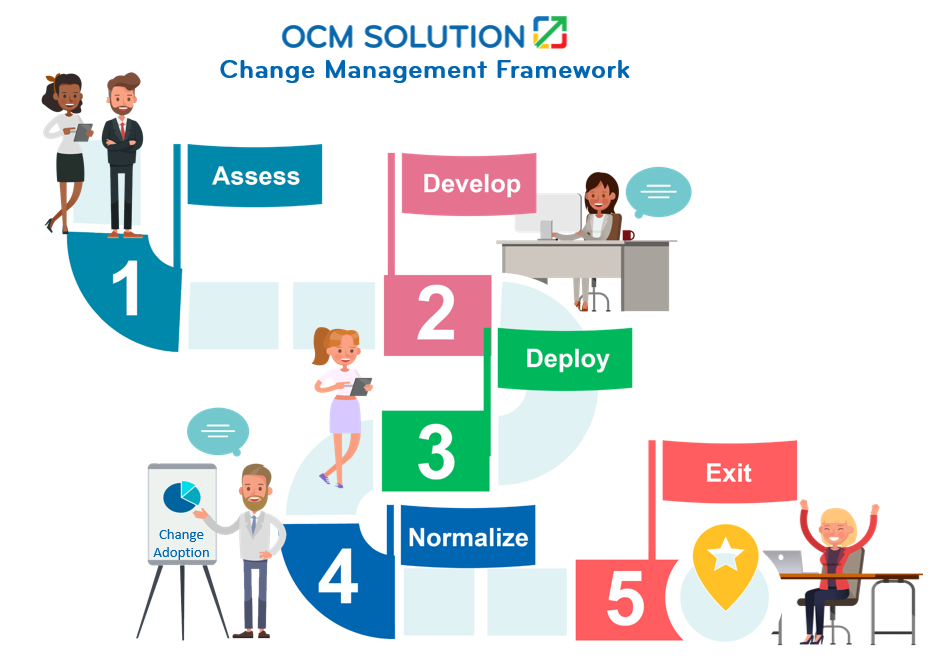
Where does this agile change management template come from?
This successful change management process flow is based on:
- 15+ Years of OCM Practice: OCMS’ founder is a seasoned change practitioner & trainer. He had tried the ADKAR change management model and many others. He found them lacking the comprehensive steps he needed. This led to the development of the OCMS Change Management Framework.
- Science + Art: The OCM Solution Framework integrates a perfect balance of structured methodology and practical, hands-on experience.
- OCM Community: This change management theory has been refined from years of practical use on OCM projects around the globe.
Implementing change in an organization using the OCMS Change Framework
Phase One: Assess
In the Assess phase of the change management process, understanding the project and its impact is key. This involves various assessments analyzing the business initiative, stakeholders, change impacts, readiness, and risks, forming the basis for the change strategy.
Assessment activities:
- Ramp up on your change tasks.
- Assess project risks.
- Evaluate impacts, stakeholders, and change readiness.
- Address resistance and communication needs.
- Evaluate Change Champion Network, training, and coaching needs.
Phase Two: Develop
Phase 2 is the Develop phase. Here, data collected in Phase 1 is analyzed, forming the basis for actionable change management strategies.
Development activities:
- Create a Strategic Change Playbook.
- Develop OCM roadmaps.
- Formulate change management plans.
Phase Three: Deploy
Phase 3 of the OCM Solution Change Framework marks the deployment stage, transitioning from assessment and planning to action. This phase involves executing the overall change management plan along with individual plans for communications, coaching, training, and more.
Deployment Activities:
- Execute the Change Management Plan.
- Implement the communication, coaching, and training plans.
- Engage the Change Champions/Agents Network.
Phase Four: Normalize
Phase 4 focuses on normalizing the change. Emphasis is on sustaining the change by supporting impacted users and reinforcing new behaviors and skills.
Normalization activities:
- Provide user support and change enablement.
- Track change management successes & KPIs.
- Provide reinforcement, training, and rewards.
Phase Five: Exit
The fifth and final phase in the OCMS change management methodology involves the change management team’s exit from the project. Responsibilities are transferred and a final report is disseminated.
Exit activities:
- Transition process ownership and management.
- Complete closure tasks.
OCMS Framework Summary Conclusion
The OCM Solution Change Management Framework stands out for its flexibility, simplicity, and effectiveness. If you’re looking for a less complicated way to manage change, this is a framework to consider.
Want to get started using it now for management of change? Need something quick, easy, and free? Sign up for a free trial of OCMS Portal change management software below.
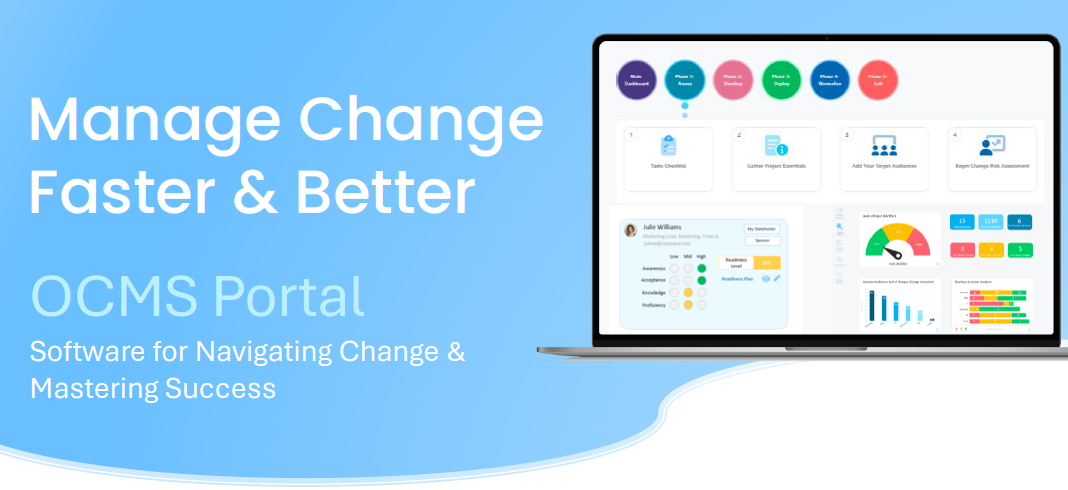
Detailed Deep Dive
A Standardized Change Management Framework for Managing Any Type of Organizational Change
Over the last decades, I have delivered a wide range of organizational change management programs.
A decade after Steve Jobs handed the reins of leadership at Apple to Tim Cook, I was hired to establish Apple’s first ever B2B Change Management Practice. In addition, I delivered change management principles to support Capital One’s acquisition of HSBC’s US credit card business, and also expanded Intel Corp’s Supply Chain Change Management Team to deliver agile change management. These are just a few examples.
Throughout my tenure as a Change Lead, I have learned and applied a wide range of change management models, including APMG’s CCMP change management methodologies and techniques, Prosci’s ADKAR Change Model, CMS Change Implementation Model, and Kotter’s Change Management Framework. I have used Accenture’s change management process flow models, McKinsey’s agile change management framework, and many more change management models.
“None of these change management models and methodologies provided me with what I needed to deliver the end-to-end change management deliverables needed for the projects I was supporting.”
In speaking with other change practitioners, I saw a need for an organizational change framework with a repeatable change management process flow that I and others can use to deliver change management for any project. It needed to be a change management framework that was more robust than what existing change management methodologies provided, and one that was based on actual real-life change management situations versus hypothetical scenarios.
Ogbe Airiodion
Sr. Change Management Lead
OCM Solution Founder
A Best-in-Class OCM Framework Has to be Repeatable, Standardized, and Easy to Use
Most business initiatives that change practitioners are involved in require strategic and tactical change management deliverables. In addition, most of these programs involve major challenges and complexities that change practitioners are asked to help resolve.
And so, I knew that for a change framework to become an effective, standardized, global change management framework, usable by practitioners across the world, and in any country, the framework needed to be intuitive – and easy to learn – so that anyone could adopt it and apply it to manage change management, and also quickly teach it to other change practitioners and managers within their organization or externally.
The free OCM Solution Organizational Change Management (OCM) Framework outlined below is the change management approach that we have perfected over the years. It is flexible, repeatable, and scalable. You can use it for a wide range of complex change programs, including those that involve Agile change management processes, as well as those that involve waterfall change management principles.
The OCM Solution Change Management Framework is a 5-phase change model that uses a proven, real, “change management deliverables approach” for practical hands-on implementation of change management versus the theoretical change management scenarios used by a lot of change management methodologies.
The phases outlined in the sections below (Assess Phase, Develop Phase, Deploy Phase, Normalize Phase, and Exit Phase) categorize the change management project actions that need to happen to conduct a successful change project from start to finish.
Each phase includes people-based deliverables for the management of change. Our change approach allows the freedom to accomplish those deliverables in the way that you or the change team feels is most optimized.
“Use it for any type of organizational change: People, Processes, Technology, Policy, M&A, Divestiture, Culture, Strategy, Org Transformation, Restructuring, Data, and more”
A Best-in-Class, Simple, Change Management Model for all Change Practitioners
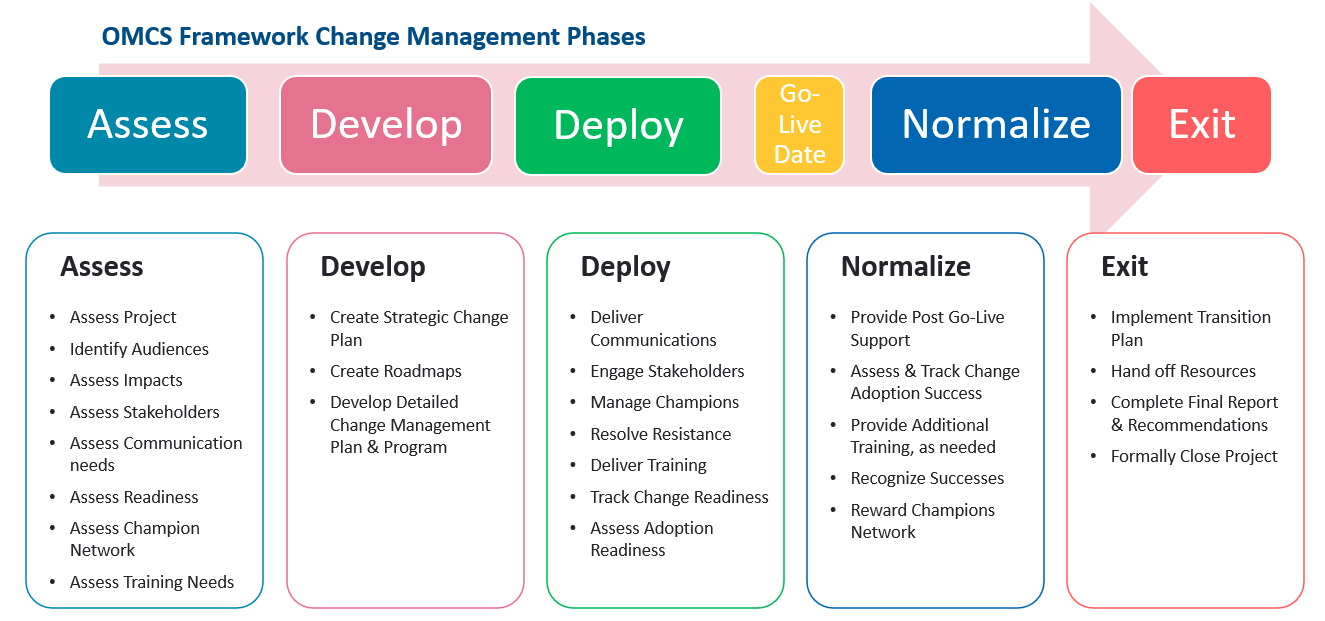
Using this organizational change management model has allowed me to hit the ground running on any project (from small to large-scale global projects) and to start delivering change management successes right from day 1.
Click here to contact Ogbe Airiodion if you have any questions or input about the change management principles covered in the OCM Solution Change Management Model or about managing change management.
The OCM Solution Organizational Change Management Framework
The OCM Solution Change Management Framework is a 5-phase change model that uses a “manage by deliverables” approach. The phases categorize the project actions that need to happen to conduct a successful change project from start to finish.
Each phase includes people-focused deliverables which require a set of tasks to achieve. Our flexible change approach allows the freedom to accomplish those deliverables in the way the change team feels is most optimized. It’s also easily scalable to any size or scope of the project and can be used with both waterfall and agile change management processes.
The OCM Solution Change Methodology which I applied to increase my change management successes at Apple, Intel, Silicon Valley Bank, Cisco, HSBC, State Street, and other global organizations involves five distinct phases.
Keep on scrolling to review each phase or click below to be taken directly to that section of the OCM Solution Framework.
See also:
- Who is this OCM Framework Designed for?
- OCM Solution Change Framework vs. Prosci vs. Other Frameworks
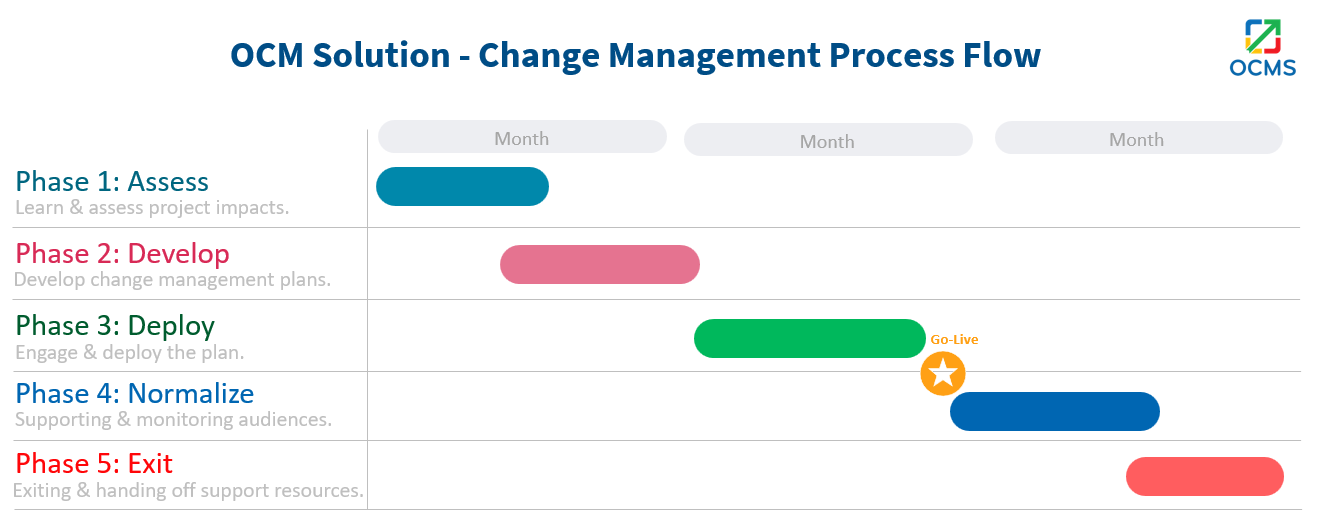
Do you have questions or feedback about change management in general, managing change management, or the change management approach outlined in the OCM Framework? Click here to contact the OCM Solution Team.
Who is the OCM Solution Organizational Change Management Approach Designed for?
The OCM Solution Change Management Framework has been designed and published for all change management practitioners, from those that are new to change management, all the way up to those like me that have decades of extensive change management experience.
Across the change management field, change practitioners often have to figure things out themselves using a trial-and-error change management approach. Some change management practitioners are certified change managers, but a lot are not. Over time with the trial-and-error change management approach, practitioners (including certified and non-certified change practitioners) often identify what works and what doesn’t work for them or for their organization.
“This free OCM Solution Change Management Model aims to provide standardization, consistency, and a defined change approach across the change management and project management community.”
Every year, our website receives hundreds of thousands of visits from change management practitioners, change managers, change leads, project managers, program leads, leadership, trainers, coaches, change agents, change champions, and more.
This framework has been designed for each of you to use to help you increase your change management successes.
Click here to contact Ogbe Airiodion if you have any questions or feedback.
Do you have questions or feedback about the change management process outlined in this Change Management Methodology guide or about managing change management? Click here to contact the OCM Solution Team.
The Art vs. Science of Change Management | OCM Solution Change Framework vs. Other Change Management Models
Some organizations I’ve worked with as a Sr. Change Management Lead (Consultant) have leveraged the Prosci change management approach based on its focus on the individual end-user. Other organizations leveraged other types of change management methodologies.
As I mentioned in the sections above, I’ve mastered a wide range of these change models to manage change management, but ended up needing to develop and perfect the OCM Solution Change Management Framework presented on this page. The reason why I needed to create this framework is because I discovered that none of the other change management frameworks provided me with the components, tools, and steps needed for conducting end-to-end change management.
You are welcome to do your own independent assessment to compare all of these frameworks against the OCM Solution Change Management Framework, and come up with your own opinion regarding the adequacy or gaps with these other organizational change management models. Don’t hesitate to message us with your findings or any feedback: Contact OCM Solution.
In general, any type of change management methodology should be considered the Science of change management. It is the same concept involved with getting an education or getting trained on something. You learn the science (method) of that topic.
Over time, you will need to build the Art of change management, which involves developing proficiency. With years of experience, which includes seeing what works and what doesn’t work at various organizations/projects, you can build upon any change methodology, and perfect your own Art of change management implementation, which is what I’ve done over the years.
The Science (the methodology) of change management is great because it provides structure. But, the Art of change management is even more important because it is centered around the actual end-to-end implementation, hands-on experience, and working on change programs.
- The “Art” of change management involves the real-life implementation, experience, templates, samples, change management best practices for each step of the way, tools, day-to-day change challenges, and lessons learned from implementing change programs.
- The “Science” provides an outline of what should happen, and the “Art” involves coloring in that outline with the processes and tangible activities needed to bring a change program to life.

The OCM Solution Change Methodology aims to provide you with a quick ramp-up on the Science as well as the Art of change management. Let us now discuss the various stages of our Change Framework so you can determine how to best leverage this for implementing change in an organization, and for your change programs.
Don’t Miss: Making a Business Case for Implementing Change in an Organization
Do you have questions or feedback about the change management process outlined in this Change Management Methodology guide? Click here to contact Ogbe Airiodion or the OCM Solution Team.
In addition, let us know if you have identified a change management theory or process flow that you would like us to include in one of our publications that you believe will help other change practitioners.
A Defined Waterfall & Agile Change Management Methodology
for New and Experienced Change Practitioners & Managers
| PHASE ONE ASSESS |
During the first phase in the change management process for managing change management, you must learn about the project and impacted users so you can plan how to enable the organization’s change. This involves conducting a series of change assessments to analyze the business initiative and its deliverables, as well as assessing stakeholders, change impacts, organization readiness, and change risks to get the definition of change for this project.
You can think of Phase 1 (Assess Phase) as the phase in your organizational change framework where you are learning and understanding.
Change assessments are a vital first step in any change management techniques or approaches you use. Your findings from these change assessments are critical as they will provide output and insights for you to develop your change management strategy and playbook (Phase 2), and will drive the scale of the change management plans that you develop. For example, if your change impact assessment shows a severe level of impacts to a specific group, then your change plans for engaging that group needs to be more extensive than the plans for a less impacted group.
Complete the series of change assessments listed below.
Phase 1 Deliverables to Complete
Each phase of the OCM Solution Change Management Framework includes specific recommended deliverables for the management of change. Of course, you may not need all of them. The exact assessment deliverables you require and the order in which you perform your assessments will depend upon your project scope and requirements.
Understanding how one assessment connects to another can help when you are reviewing approaches to managing organizational change. For example, before you can even begin to assess stakeholders and user resistance, you typically need to understand the project by doing a project assessment. Once you do that, you need to assess the change impacts of the project to see which target groups are being impacted and by what level of magnitude.
During the first phase of implementing your change program, you’ll want to conduct the change assessments listed below.
- Ramp up on Your Change Tasks
- Assess the Project Risk & Successes
- Assess Impacts
- Assess Stakeholders
- Assess Change Readiness
- Assess Resistance to Change
- Assess Communication Needs
- Assess Change Champion Network
- Assess Training Needs
- Assess Coaching Needs
Quick notes:
- Depending on when you join a project, some of these assessments might already have been done or started, and your role will be to leverage what was already completed, and expand it or verify that it was accurately done.
- Sometimes when I join a project, the project management lead or team would have already conducted some level of stakeholder analysis or impact assessment, but I often have to conduct additional assessments to fill in gaps. Other times nothing has been done, and I start from scratch.
Ramp up on Your Change Tasks
The first thing you need to do when you are brought in to support a project is to ramp up on your change tasks and the project you are supporting. This will involve meeting with the Program Lead, Project Manager(s), Sponsors, and other stakeholders.
You will also want to begin drafting out the change management tasks and deliverables for managing change management that will be part of your overall change management plan. This is just a rough draft at this point. It helps to use a standard change management workflow template with pre-populated tasks that you can edit as needed per project.
The goal at this first step is to understand the scope, scale, magnitude, timeline, WIIFM (“What’s in it for me” for impacted users), and overall objectives of the program. This knowledge then allows you to effectively determine how to conduct your change management assessments that are critical to developing your change plans and increasing your successes.
Without going through this ramp-up at the beginning, you will always be one step behind, and will always be playing catch-up, including during program meetings, where conversations might be flying over your head.
This is not an ideal state for you if you are a Change Practitioner that has been assigned to a project. Understanding what is being discussed, as well as the project objectives will go a long way in your change management implementation success.

Read more: Best Project Assessment Guide | Change & Project Management
Do you have any questions about the definition of change or this process and change management framework? Please reach out and let us know.
Assess the Project Risk & Successes
Oftentimes, change practitioners fail to conduct a change risk assessment, which is a mistake. To ensure you avoid that mistake, make sure you perform an assessment of the change risk for any project you are providing change management for.
It’s best to separate your risk assessment into three key stages so you can accurately reflect risk for each. This is especially important while in early stages to ensure an overall risk score isn’t skewed because you simply haven’t progressed to other stages of the project yet. This can leave change managers in the unenviable position of having to explain that everything is going well, even though an OCM risk matrix shows high risk because all stages are being scored together.
No matter what change management theory or change management principles are guiding your project, conducting a risk assessment can ensure you’re not blindsided by potential issues that could jeopardize the success of your project.
A change management risk assessment is the process of analyzing, identifying, understanding, and managing the risks that a change management program will face throughout the lifecycle of the change implementation.
Read more: How to Conduct Effective Change Risk Assessments?
Please reach out if you have any questions about change definitions, the management of change process, or change and change management in general. We’ll be happy to help!
Assess Impacts
One of the most critical deliverables you need to complete as soon as possible will be conducting an organizational change impact assessment.
An organizational impact assessment is the set of tasks that you perform to document and identify the impacts of a change. When an organization implements changes to its business processes, technology platforms, organizational culture, job roles, policies, or when it expands to new locations, there are often individuals and groups that are impacted by the change initiative.
Knowing who is going to be impacted, how they’re going to be impacted, and the severity of that impact to them is critical if you want to implement your organizational change project successfully. Your approaches to managing organizational change, such as your communications, manager coaching, and where to position your change champions network will depend upon this assessment.
The change impact assessment is a key foundation of any OCM framework, including the OCM Solution Change Framework.
Read more: Best Change Impact Assessment | Everything You Need to Know.
Assess Stakeholders
As part of the first stage of implementing the OCM Solution Change Framework, you will want to conduct an effective stakeholder analysis which will help you identify which stakeholders are being impacted by a change project and where each one stands.
“For example, which stakeholders are receptive to the change? Which ones are strong advocates? Which ones are resisting the change? Etc.”
It is important to understand the current state that each stakeholder is currently at, as well as the future state where you need each one to be in relation to their support for the change project.
What’s the Difference Between Target Audience and Stakeholders?
Stakeholders are more actively engaged with and are a small percentage of your entire target audience. They are key representatives of the impacted groups (your target audience), and have a “stake” in the change. They are often leaders, executives, influencers, and other key audience representatives.
You will want to work with the project team, program managers, and program sponsors to identify stakeholders that should be added to your stakeholder list for active engagement.
- Read more: How to Perform the Best Stakeholder Analysis
- Also, review this page: Stakeholder Engagement and Management
Assess Change Readiness
Performing an organization readiness assessment, also referred to as a “change readiness” assessment is almost as important as conducting a change impact assessment. A change readiness assessment helps you gauge how ready impacted organization(s) or groups are for a change. In essence, it is the set of tasks that you complete to identify how prepared an organization is for a particular change.
As you go through your change implementation model for readiness, you will be assessing things like general awareness of the change, receptiveness to the change, change fatigue (capacity to take on one more change), and overall preparedness for the change program’s Go-Live date.
Change management best practices include more than a single readiness assessment. Readiness assessments are typically done a few times throughout the project, with the goal being to move impacted groups closer towards “Go-Live” readiness. In addition to doing the Readiness Assessment in Phase 1 (Assess Phase), it’s also generally done one or more times during Phase 3 (Deploy Phase) of the OCM Solution organizational change management approach.
The level of change readiness that is assessed will be based on the scale of the change itself, as well as the severity of the impacts. When a business goes through change, the impacted audience groups need to be prepared and ready for the change.
If interested, you can read more here: Change Readiness Assessment Guide | All You Need to Know
Assess Resistance to Change
The more that impacted users believe their current way of day-to-day work (internal users) or way of conducting business (external users) will be impacted by a change, the more risks, low receptiveness, and opposition you should expect to see during the change. As such, you’ll want to conduct a proactive resistance management assessment during Phase 1.
You can leverage your target audience and stakeholder assessments for any individuals identified as having mid to low support for the change project. It’s also important to speak with projects leads, managers, and supervisors to uncover any potential resistance you can during your assessment.
Resistance management is vital in any change management theory or approach, including whether you are using the OCM Solution Organizational Change Framework, the ADKAR Change Management Model, or another of the change management models or methodologies.
During resistance management activities, you’ll need to identify and manage resistance through both proactive and reactive methods. Proactive resistance assessment is done in Phase 1 to identify potential resistance and address it before it can grow. Proactive and reactive resistance management is done during Phase 3 (Deploy Phase) and Phase 4 (Normalize Phase). During these phases, you will put your proactive resistance management plan into action and will at the same time be confronted with and manage resistance reactively as it arises.
Read more: How to Really Manage Resistance to Change
Assess Communication Needs
Communications are a big part of stakeholder engagement during the change management process. In this step, you’ll be assessing overall communication needs for various groups. It’s good to do this after you’ve conducted the change impact assessment and change readiness assessment because both will inform your communication plan.
For example, some of the things you’ll assess for communications are:
- Which groups need to be communicated with?
- How much communication those groups need?
- What types of communications will be needed?
Gathering these initial details now will be important when you get to the planning stages and are drafting up a detailed OCM communications plan.
Read more: Top Change Management Communication Plan Guide (Step-by-Step)
Assess Change Champion Network
The Change Champion & Agent Network is a group of employees throughout the organization that help champion the project in their respective departments/teams. They can help cascade communications about the project, assist colleagues with basic questions, and report any potential resistance to the change management team so it can be addressed proactively.
Projects that are impacting smaller groups of stakeholders may not need a change champion network. But those impacting larger groups and multiple departments will benefit greatly from these extra “boots on the ground.”
In this step, you’ll be assessing the need for a change champion network and reviewing information from past projects to see if there are existing candidates with champion network experience. Should you identify that a champion network would be beneficial to the project, then you will identify where they are needed and gather contact information for managers in those departments that you can ask for recommendations.
We recommend that you establish a Change Network as part of your change management program. Many change management techniques establish that an active and robust Change Network is a highly effective mechanism to enable change from within the business units. Research shows that people get through organizational change by relying on their relationships with others in the workplace.
Change Networks assist with:
- Leading Change Adoption: Change Champions are early adopters of new ways to work and advocates for the value of change within their organization
- Mitigating Risk: Issues are flagged and real-time feedback is captured in a timely manner and actioned upon before they become larger systemic problems
- Operational Support: Employees feel there is a structured support network that provides on the job training and will help the new process run smoother from the start
Read more: Launching Your Change Champion Network – Instructions, Samples & Templates
Assess Training Needs
Does the project require formal training? This is what you will be determining when you’re doing a training assessment. For projects where users need to learn new skills, software, rules, or processes, you’ll likely need to coordinate training as part of getting stakeholders ready to adopt the changes required successfully.
During this stage, if you determine that training is needed, you can begin assessing the types of training, which groups need training and gathering details that will be used to help craft a training plan in the next phase.
Read more: Complete Guide | Best Training Plan for Staff, External Groups, and Others
Assess Coaching Needs
You can think of coaching as mentoring or a more personalized version of training. You might coach department managers on how to support the organizational transition and provide encouragement for their teams. You may also use coaching to teach new change champion network members what they need to do to be successful.
Assess whether coaching is needed based on the scope and parameters of the project. If it is needed, then you’ll want to assess who needs coaching and what types of coaching are needed.
Read more: Best Coaching Plan for Coaching Leaders, Teams, Clients, Employees
Change Management Theory Overview: Phase 1 (Assess Phase)
When implementing change in an organization, whether you’re a seasoned pro or someone that’s brand new to change management, it helps to know the “why” of the deliverables that are required.
We’ve included a page below from our free guide on change management techniques using the OCM Solution change management principles. This provides a helpful overview of your deliverables during this phase and how they connect to what you’ll need to do.
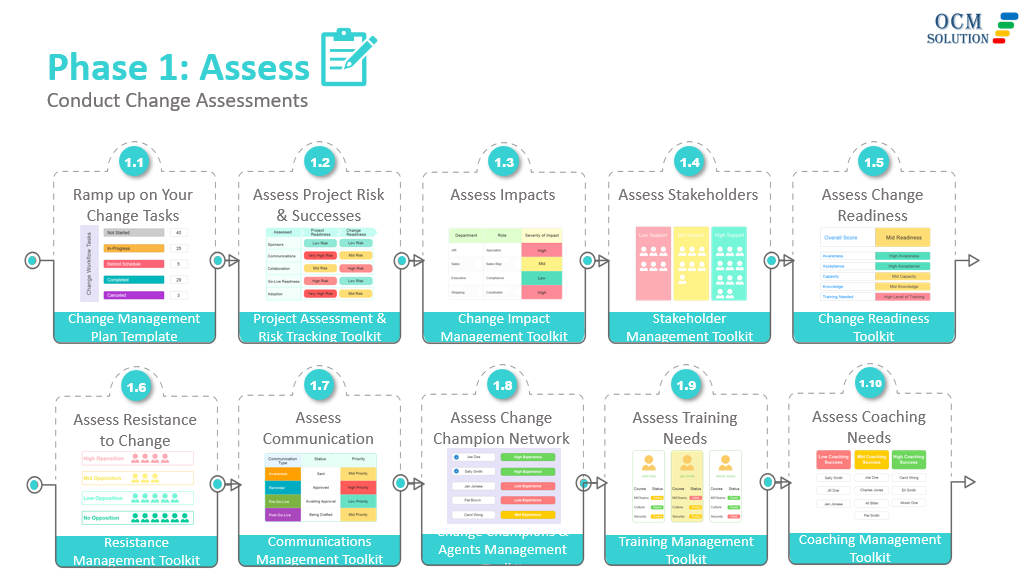 Download our Free Guide for a comprehensive snapshot of all the OCM Solution Phases of Change Management and their key deliverables.
Download our Free Guide for a comprehensive snapshot of all the OCM Solution Phases of Change Management and their key deliverables.
This change management workbook uses simple terms to explain the steps that a change manager takes to drive successful change (it’s part of our OCM Solution Change Management Certification course).
Download OCM Solution Change Model Overview PDF
Download OCM Solution Change Model Overview PPT
Summary of Ogbe’s Activities
Here is a summary of my activities when I am completing the first phase of our OCM Framework. This will allow you to put things in perspective for conducting your own activities.
- I generally start out on a project by hitting the ground running right from day 1. I focus on ramping up and working with the project sponsors and program managers to understand the scope, objectives, goals, issues, risks, roadblocks, milestones, timeline, and overall vision of the initiative or program.
- Next, I’ll review the company/group/team’s change management playbook and framework. Most organizations don’t have a documented change management framework or methodology, and so I’ll often propose the OCM Solution Change Management Framework. For those organizations that have an existing change management playbook, I often align my change approach to theirs. And if their framework has gaps, I’ll propose the OCM Solution Change Management Framework that can help strengthen their own change playbook.
- My change management approach during the first phase involves conducting a series of assessments including change impact assessments to identify business processes, technology solutions, job functions, and organizational groups that will be impacted by the change.
- I also conduct a target audience analysis, which allows me to create a matrix of impacted employees and front-line managers.
- In addition, I will conduct a stakeholder assessment to identify the leaders and executives that will be impacted by the change, that way we can effectively engage them throughout the duration of the project.

Do you have questions or feedback about the change management models outlined in our Change Management Model review page or change and change management? Click here to contact the OCM Solution Team.
| PHASE TWO DEVELOP |
The next stage in the change management process is Phase 2 of the OCM Solution Organization Change Management Framework. This phase involves developing the change management strategic playbook and change plans that will be used to implement your change management deliverables.
In this phase of your change management process flow, you’ll be analyzing all the data that you collected in Phase 1 (Assess Phase), and putting it into an actionable change management plan for your project. It’s at this phase when you’ll need to confirm whether you are doing a waterfall or Agile change management process.
You’ll be allocating resources, deciding on a timeline and budget, and creating milestones to help chart progress along the way. The work you do in this phase of your change project sets you up for your deployment of plans during Phase 3.
You can think of Phase 2 (Develop Phase) as the phase in your change management theory where you are strategizing and planning.
During this second phase of change enablement, you’ll be performing the following activities.
Note: Your change plans will include multiple plans for different areas of implementing change in an organization (training, communications, coaching, resistance management, and many more). The planning you do will depend upon the scope and requirements of your project.
Create Strategic Change Playbook
A change management playbook outlines the strategies that will be used to deliver change management during the implementation phase, including how you plan to deliver your communication campaigns, how you plan to engage stakeholders and end-users, how you plan to get impacted users and groups ready for the change, how you create, conduct, and track your training programs, how you will manage resistance, and more.
The strategic change management playbook is also often used to familiarize key stakeholders, firm leaders, project resources, and program leads with the organizational change management methodologies or methodology being leveraged for the program.
OCM Solution provides a free Change Management Strategic Playbook PowerPoint template that you can use. Sign up for a free trial now, then look for in the Tools > Free Resources section.
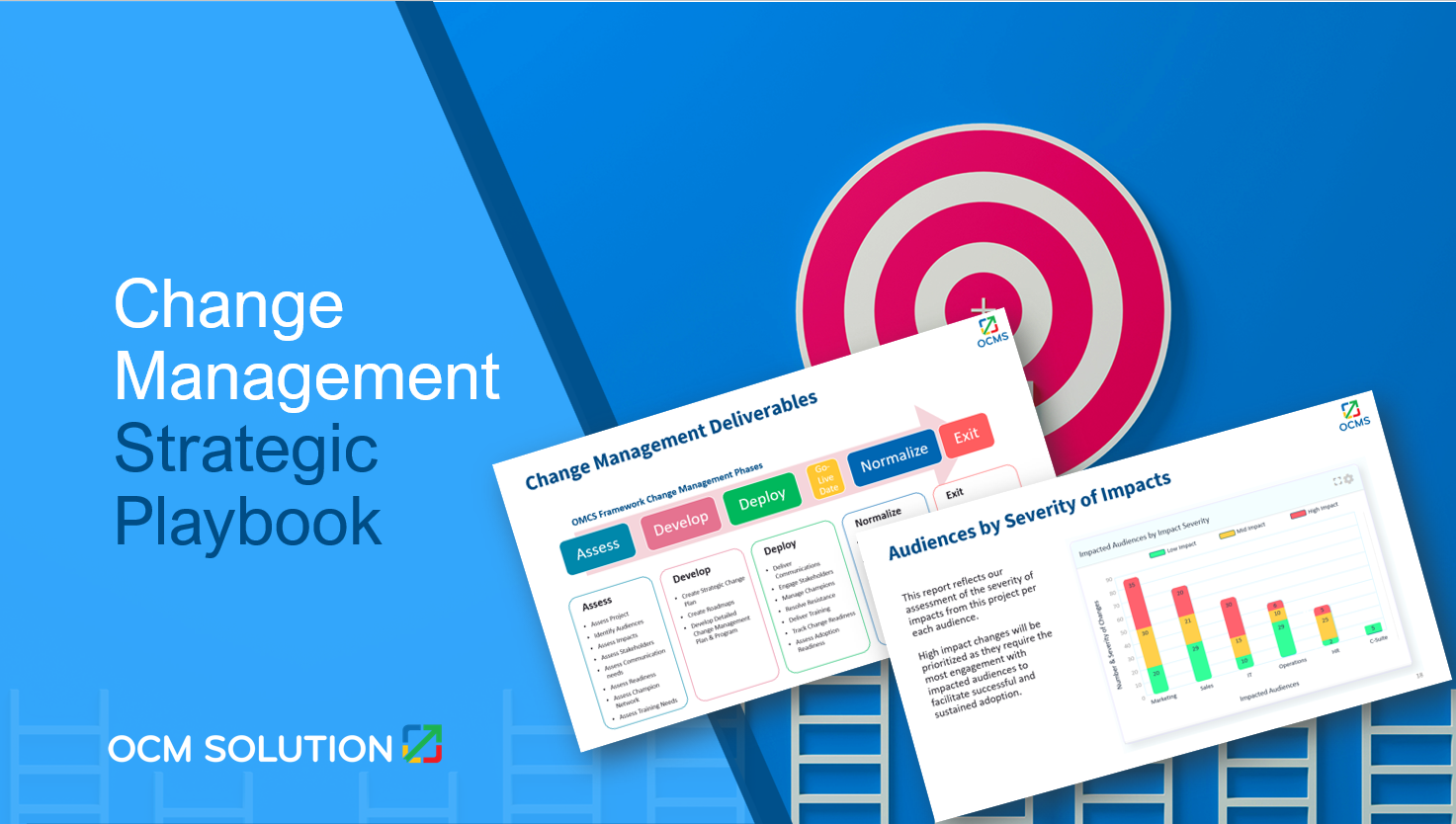
Create Roadmaps
When developing your strategy, you should also create a robust change management roadmap. Ensure that you align your roadmap to the program’s implementation timeline.
This visual tool is an important way for change project managers to “tell the story” of their project in a condensed and comprehensive view. A version of the change management roadmap is typically included within the change management strategic playbook. The roadmap will highlight key deliverables, project dependencies, milestones, and other dates that impact your waterfall or Agile change management processes and timeline.
The OCMS Portal has free Change Management Roadmap templates that you can use. Learn more about this change management software here.
Develop Change Management Plan
Next, you’ll convert your Change Management Strategic Playbook and Change Management Roadmap into actionable steps and approaches to managing organizational change.
Your change management plans will drive your activities during your project and help ensure everything is executed according to project requirements. Where your Strategic Playbook tells what you plan to do, your various change plans lay out how you will do those things.
We have developed and published detailed guides on how to develop your respective change management plans. Click on any of these guides below for creating your change management plans:
- Organizational Readiness Plan
- Communication Plan
- Stakeholder Engagement and Management Plan
- Target Audience (Impacted End-Users) Engagement Plan
- Training Management Plan
- Change Management Metrics & KPIs Plan
- Change Champions & Agents Networks Plan
- Coaching Plan
- Resistance Management Plan
- How to Establish a Change Management Working Group
- Making a Case for Change Management (Benefits of a Change Program)
Change Management Strategies vs. Change Plans
What’s the difference between a change management strategy and a change management plan?
- Strategy is stating what you will do
- A change management plan is a documentation of exactly how you will do what you stated you would do
Here are examples:
- Change Team: “When we roll out the change we will provide weekly communications to provide awareness and status update.” (This is a strategy)
- Change Team: “We will create detailed communications plans, as well as training plans to educate Sales, Finance, Operations, and Manufacturing teams in the US, Canada, India, UK, Europe, Africa, and Asia.” (This is a strategy).
- Developing and completing any of these plans above that the Change Team has stated (strategized) they will do is an example of a “change management plan.”
Change Management Theory Overview: Phase 2 (Develop Phase)
Below, you’ll find a roadmap from our free PDF & PowerPoint guide on the change management process flow for Phase 2. This overview highlights the various change management plans and deliverables needed during this phase of the OCM Solution change management methodology.
Summary of Ogbe’s Activities
Here is a summary of my activities when completing the second phase of the OCM Framework. This will allow you to put things in perspective for conducting your own activities.
- Based on the results of the series of assessments that I conducted during the first phase (discussed in the sections above), I then develop the end-to-end change management strategic playbook that outlines the strategies that will be used to drive adoption for the project or program.
- Every project and initiative is unique. And so a change strategy needs to match the scale of impacted end-users, as well as be structured to address each group’s readiness for, and willingness to support the change.
- It also needs to be flexible and robust enough to support the scope and severity of the change.
Use our free change management plan template for any type of project. It’s based on the OCM Solution Change Management Framework, but can be adapted to use with the ADKAR Change Management Model, Kotter 8-Step Model, or any other change management models.
Do you have questions or feedback about the change management process or the agile change management process referenced in this Change Management Methodology guide? Click here to contact the OCM Solution Team.
| PHASE 3 DEPLOY |
The 3rd phase of the OCM Solution Change Framework implementation is your deployment phase. This is when all your assessing and planning will transition to action. You will be executing your overall change management plan as well as each individual plan for communications, coaching, training, a change champions/agents network, and more.
If you’ve gone through the Phase 1 and Phase 2 steps, then you’ll be well prepared for implementing this phase of the OCM Solution Change Model.
You can think of Phase 3 (Deploy Phase) as the phase in your change management process flow where you are engaging and executing.
We have developed and published detailed guides on how to implement your respective change management plans. Click on any of these guides below, if you haven’t done so already.
- Organizational Readiness Plan
- Communication Plan
- Stakeholder Engagement and Management Plan
- Target Audience (Impacted End-Users) Engagement Plan
- Training Management Plan
- Change Management Metrics & KPIs Plan
- Change Champions & Agents Networks Plan
- Coaching Plan
- Resistance Management Plan
- How to Establish a Change Management Working Group
- Making a Case for Change Management (Benefits of a Change Program)
Change Management Theory Overview: Phase 3 (Deploy Phase)
Below, you’ll find a workflow from our free change management best practices guide, highlighting Phase 3. This overview breaks down in detail the actions and engagement you’ll be delivering during this phase using the OCM Solution change management principles.
Summary of Ogbe’s Activities
Here is a summary of my activities when completing the third phase of the OCM Framework. This will allow you to put things in perspective for conducting your own activities.
- For the third stage of the organizational change management process, I focus on executing the detailed plans I created in Phase 2, and delivering communications, training, engagement, organization readiness, and other change deliverables.
- I utilize multiple communication mediums including emails, newsletters, videos, podcasts, 1-on-1 with key leaders, group meetings, internal social media, and blogging. I also leverage the help of key leaders, and managers to waterfall down the communications to their direct reports.
- These are change management best practices. Decades of studies have shown that employees prefer getting change communications from their managers and leaders.
- For projects that require an agile change management framework, I often develop and deliver my change management plans using an iterative method. For waterfall processes, I normally take a standard sequenced change management methodology approach.
- My change approach during this phase of the OCM Solution Change Management Methodology implementation also involves developing and implementing leadership engagement activities, end-user touch points, coaching, resistance management, and training, as well as standing up a change champion network to help facilitate the change across impacted functions.
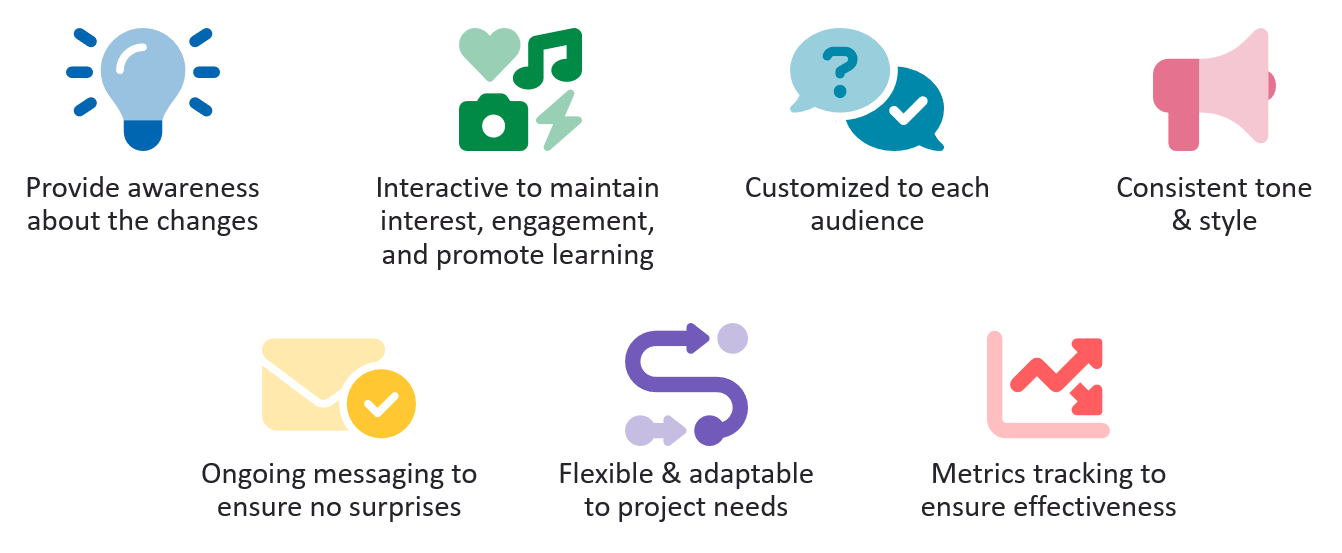
Do you have questions or feedback about the change management process outlined in this Change Management Methodology guide? Click here to contact the OCM Solution Team.
| PHASE 4 NORMALIZE |
The next stage of the OCM Solution change management approach involves sustaining the change. During this phase, you will be supporting impacted users and helping them reinforce the new behaviors and skills.
This is a critical stage of any transformation because if not performed, users can revert back to the old ways of doing things and develop workarounds – which will undo much of the work you’ve accomplished during Stage 3.
It is at this stage when issues and resistance are likely to crop up because users are working with the new process in their daily workflow and will likely have questions and need support. During the Normalize phase, you want to provide plenty of user support in the form of a help desk, FAQs, additional training, etc. with a goal to cement the new change so it is sustained and becomes the “new normal” for users in the organization.
After you go-live, you need to continue assessing and identifying resistance, and then applying proactive and reactive mitigation plans to overcoming resistance to change.
You can think of Phase 4 (Normalize Phase) as the phase in your change enablement where you are supporting and monitoring.
Here are the key deliverables you need to deliver during this fourth phase of the OCM Solution change management process:
Don’t Miss:
Track Change Management Successes & KPIs
When it comes to tracking and measuring organizational change management, including how employees, managers, or customers are adopting and transiting through a change, there are two key areas that you need to focus on:
- Change Management Adoption & Enablement KPIs
- Change Metrics
Leverage the work you did in Phase 2 during the creation of the Change Management Plan and a tracking and measurement protocol for the project. You’ll need to track metrics such as change readiness, user experience, user engagement, communications success, training success, user adoption of the change, and more.
Sending out surveys to users, managers, and your change champions network is a helpful way to capture the metrics that you need. Other methods you can use to capture key KPI data on your change enablement are to meet with managers and change champions to get their input on “water cooler employee conversations” on the change, as well as having them pass direct end-user feedback to you.
This tracking and reporting is to help you identify areas that need attention, learn what’s going well, and for your reporting to sponsors, key stakeholders, executives, and others on the change adoption.
Read more: Change Adoption Metrics & Measurement
Provide Reinforcement, Training, Rewards
Mitigating Resistance & Roadblocks
After you “go live,” you need to continue assessing and identifying change risks / resistance, and then applying proactive and reactive mitigation plans to overcoming these change risks. You may also need to work with the appropriate departments, groups, leaders, to overcome roadblocks that have come up.
An example of change management techniques for working with others to resolve roadblocks may be coordinating with the trainers or a software vendor to schedule additional user training sessions if you find that users aren’t yet fully comfortable with a new process or application.
Resolving adoption and enablement roadblocks is needed irrespective of whether your project involves an agile change management process or a waterfall process.
- Read more: Mitigating & Resolving Roadblocks to Change Adoption
- See also: Reinforcing New Behaviors – Change Management Best Practices
Conduct Follow-Up / Provide Support
This phase of the OCM Solution change management principles requires diligent follow-up and “check-ins” with your impacted users, stakeholders, and champions network to ensure everyone is on track and adopting the change successfully.
You will also want to provide user support in several different ways (office hours, FAQs, 1-on-1 coaching, updating documentation and guides, etc.) and communicate with users regularly so they know where to find and how to access your support and user resources.
Key follow-up activities:
- Follow up with trainees and managers to identify additional training needs
- Follow up with managers to identify post-deployment issues
- Work with necessary parties to resolve issues and roadblocks
- Conduct support calls, office hours, and post go-live follow-up training
Celebrate Change Successes & Reward Teams
Something that is key whether you are following a waterfall or Agile change management plan is identifying and celebrating successes for the project. Use these celebrations and public acknowledgment of milestone achievements to reinforce the change.
Tips to celebrate quick wins and early successes:
- Constantly seek out evidence of progress in the project
- Watch for the achievement of major milestones and identify early successes, even if small
- Organize ways to recognize groups and individuals that have achieved success. Make it public
- Use normal staff meetings or regularly scheduled department meetings as an avenue for recognition of achievement
- Ensure that key stakeholders are aware of these achievements and involve managers in the chain of command to award these recognitions.
Read more:
Change Management Theory Overview: Phase 4 (Normalize Phase)
Below, you’ll find an overview from our free PDF & PowerPoint guide on the organizational change management for Phase 4. This overview breaks down in detail the various change management plans and deliverables during this phase of the OCM Solution change management methodology.
Reminder: This change management guide can be downloaded for free. It uses simple terms to explain the steps that a change manager takes to drive successful change.
Download OCM Solution Change Model Overview PDF
Download OCM Solution Change Model Overview PPT
Summary of Ogbe’s Activities
Here is a summary of my activities when completing the fourth phase of the OCM Framework. This will allow you to put things in perspective for conducting your own activities.
- For this phase, my change management approach involves tracking and measuring user adoption of the change – before, during, and after Go-Live
- For projects that require an Agile change management framework, I often conduct my tracking using an iterative method
- Part of this process (for Agile change management processes or waterfall) involves collecting and analyzing feedback and adoption metrics (training performance, training attendance, usage of new processes and solutions, grassroots feedback from front line managers, FAQs, # of people requesting help, # of people developing workarounds & shortcuts, and many more).
- Another change approach that has worked very well for me involves celebrating quick wins and successes, and also rewarding the change champion network (e.g., bringing their involvement and participation to the attention of senior leaders).
Do you have questions or feedback about the various phases of change management outlined in this Change Management Framework guide? Click here to contact the OCM Solution Team.
| PHASE 5 EXIT |
The final phase of the OCM Solution Change Management Methodology is the fifth phase, and involves the change management team / resources exiting the project.
At the end of any transformational change, the change management team will need to transition out of the project. Part of this transition needs to involve a transfer of responsibilities from the change management team to a designated group that will be determined by the program leads. A designated group might be a group within HR, Program Management Office, or some other group.
For small projects, such a transition will be minor. For large projects, the steering committee might need to be involved as such a transition will require careful planning and management.
In the Exit phase, any temporary tools or assets needed only for the change management process, but not beyond, are dismantled or disengaged. Knowledge and assets are handed off to the permanent team(s) and the change management function for this project is formally closed out.
You can think of Phase 5 (Exit Phase) as the phase in your organizational change management framework where you are handing off and closing out.
Here are the key deliverables during the final phase of the OCM Solution change management process flow:
Implement Transition Plan
During Phase 2 (Develop Phase), you would have created a transition/change exit plan and you’ll be deploying that in Phase 5. It includes closing out any functions, agreements, or tools that were only needed during the duration of the transition (temporary training portal, consulting agreements, etc.) and doing a knowledge off-loading and responsibility hand-off.
Ensure the new team has access to any documents, “best practices,” online tools that may stay in use for the new process/procedure, and any other assets this permanent team may need to properly take over responsibility for the changed process or system.
Complete Change Exit Tasks & Final Report
You’ll provide your final Change Project Report to project sponsors, executives, critical stakeholders, and others during Phase 5 (this is pertinent whether using a waterfall or Agile change management plan). If you have been tracking your change project KPIs during Phase 4, as noted above, then you can generate analytics from your tracking metrics to include in your final change project report.
You want to ensure that in this final phase, you generate a project post-mortem, which can be included as part of your final change management report or as a separate document. This report is applicable no matter which change management models you may be using (ADKAR Change Management Model, OCM Solution Change Management Framework, McKinsey’s model, or another).
Your project post-mortem should incorporate lessons learned, things that could be done better, achievements that you want to repeat, etc. This type of change management document is very helpful when it’s time to plan future projects because you can build upon past knowledge and experience.
Read More: Best Change Management Metrics & KPIs for Change Mgrs
Don’t Miss: Change Management KPI Templates & Metrics Dashboard
Change Management Theory Overview: Phase 5 (Exit Phase)
Below, you’ll find an overview from our free guide that includes the organizational change management deliverables for Phase 5. This overview describes the various change management plans and activities during this phase of the OCM Solution change management process flow.
Do you have questions or feedback about the change management process and OCM framework outlined in this Change Management guide? Click here to contact the OCM Solution Team.
Toolkits & Templates for the OCM Solution Change Management Model
The OCM Solution Change Management Framework is one of the few (if not only) change models that is backed up by a robust set of change management tools and templates. The OCM Solution change management software is a cloud-based platform that includes toolkits, samples, guides, and other tools for conducting an entire change project from start to finish.
This includes toolkits for change impact assessment, stakeholder assessment, communications management, training management, change metrics & KPI tracking, and much more. The platform is fully collaborative and allows you to work on multiple projects and assign multiple users or guest users. It also has a hybrid feature that enables work offline in Excel if you like.
You may have even begun using our popular online change management tools first and because of them became interested in learning more about the methodology behind them.
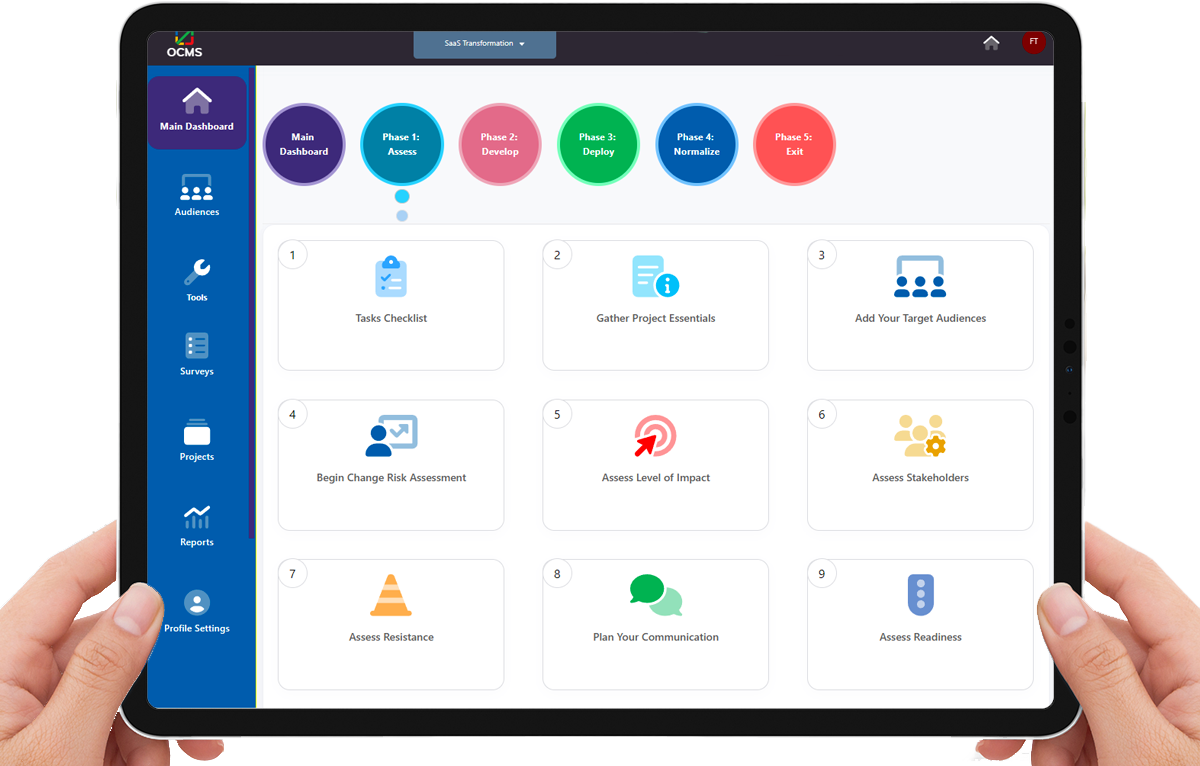
You can learn more and request a free demo by visiting our OCM Solution Change Management Software page.
Conclusion: Best OCM Framework
Whether you are implementing an Agile change management plan or template, or seeking a traditional waterfall change management methodology, this OCM Solution change implementation model is designed for you.
Program management focuses on the technical side of change (designing, building, and deploying solutions), while change management is the people side of any organizational change, and involves helping stakeholders and impacted users to embrace, adopt, and become proficient in using the new solutions.
The OCM Solution Organizational Change Management Framework comes highly recommended based on its flexible structure and very hands-on approach.
As organizational change practitioners, our role involves helping to increase program success and end-user adoption. Implementing the OCM Solution Change Framework outlined on this page (and the linked pages) will go a long way in helping increase your change management successes and performance when guiding impacted users as they transition through their change curve and milestones.
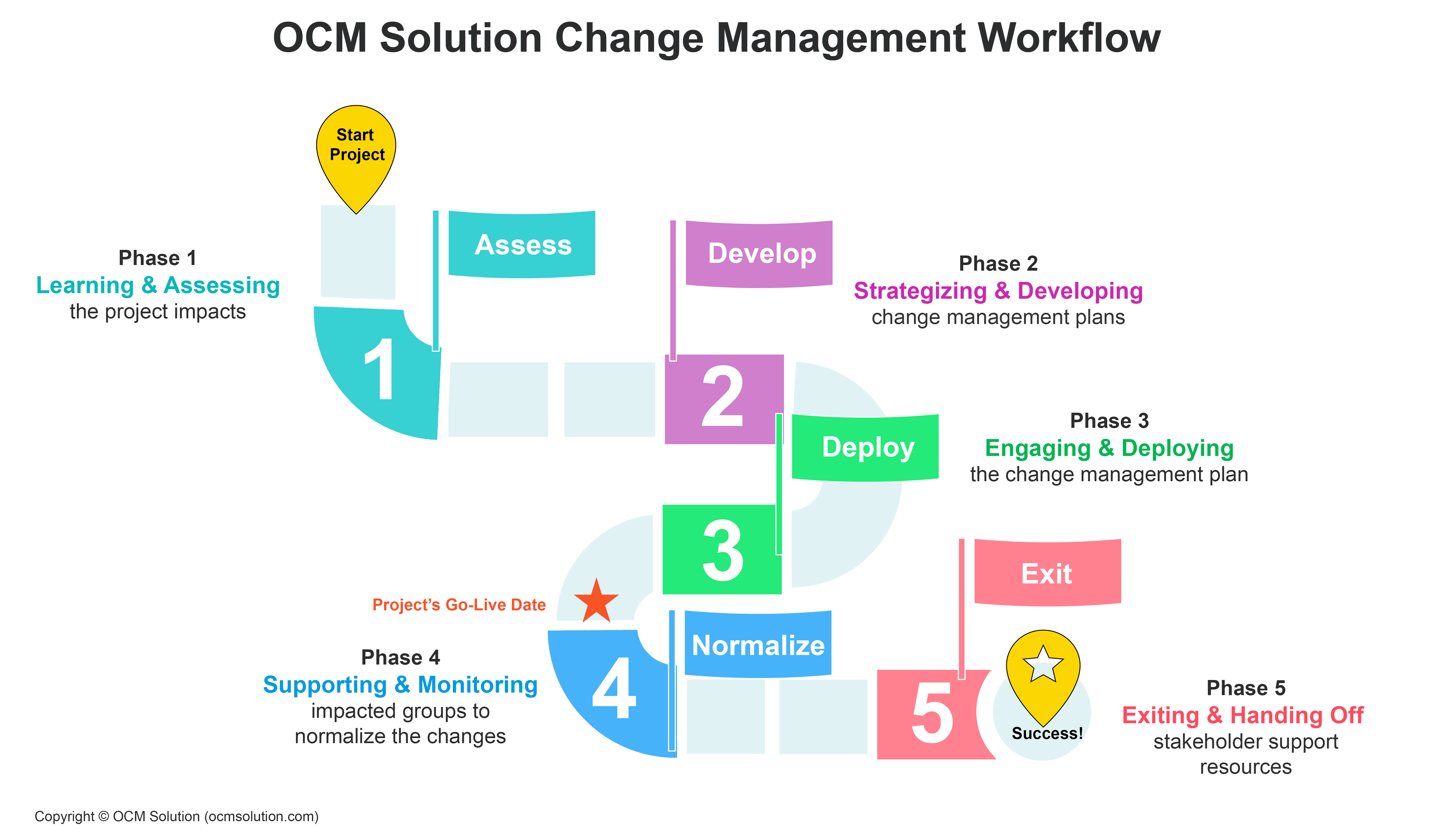
You can take what is presented on this page, and apply it to any type of project, small or large. Simple or complex. Local or global. You can also let me know if you have any questions. The change management community is a close-knit and ever-changing community, and I am a big advocate of this community.
Note that it is normal human behavior not to like change. Even when people, including employees, know that a change is beneficial to them, it still requires an extended level of effort for them to change their habits and learn new ways. And so, to successfully get people to willingly transition from their current state to a future state and to want to support a change, it is essential that you apply a structured change process, combined with an effective change management approach.
If you’ll like to share feedback on best change approaches and change management models that have worked really great for you, kindly click here: Contact Ogbe Airiodion, and send me a message about your approach.
Change management models are key sets of change frameworks and methodologies used to effectively implement change management programs. These models provide an in-depth structure for conducting organizational change. Change management models include APMG’s CCMP change management model, ADKAR Change Model, CMS Change Management Model, Kotter’s Change Management Framework, and many more change management models. Read more: https://www.ocmsolution.com/change-management-framework/
A change management framework is a structured process used to effectively implement change management programs. It provides a systematic approach to managing the various phases of an effective change management program.
Change management methodologies, also referred to as OCM frameworks (organizational change management frameworks) are structured processes that outline how to implement effective change management to increase impacted user adoption and enablement.
A change management process flow provides you with a step-by-step outline of key change management phases and high-level deliverables that need to be planned, designed, developed, implemented, and tracked to increase the success of a change management program.What are change management models?
What is a change management framework?
What are change management methodologies?
What is a change management process flow?
Note: Content on OCM Solution's ocmsolution.com website is protected by copyright. Should you have any questions or comments regarding this OCM Solutions page, please reach out to Ogbe Airiodion (Change Management Lead) or the OCM Solutions Team today. OCM Solution was previously known as Airiodion Global Services (AGS).
Image credit: stock.adobe.com.






